The week at a glance
- Brown Shrike still in Surrey
- Zitting Cisticola still in Kent
- American Buff-bellied Pipit still in County Clare
- Potential Pacific Diver in Gloucestershire
- Fascinating Larus sp. in County Sligo
It was a soggy, very mild and rather breezy week of weather this week, thanks to a deep low-pressure system that swept up through the Western Approaches and rattled the windows along many south-coast counties. Gusts topped three figures in places — like a hurricane indeed. The potentially destructive winds stirred up a few seabirds but, generally speaking, it was very much "as you were".
But it almost wasn't "as you were" at all. The famous saying "it's not over until the fat lady sings" nearly came true once more, in terms of the autumn and the megas therein, during the afternoon of 14th. News of Britain's first Rufous Turtle Dove for six years, in Aberdeenshire, was undeniably exciting. But after dark it emerged that the portly songstress had been singing the wrong words all along: the instructive and rather bedraggled bird was actually a juvenile Turtle Dove. Ensuing discussions have called for a new paper to highlight, once more, the potential problems of the species pair (or trio, if you go with the flow and consider meena and orientalis to be two, not one, species). No problems though for the Finnish birder who saw the photos of this bird and, immediately, called it right. And for anyone who had managed to get behind the wheel and hit the road, news was out in enough time to make a swift U-turn and not burn too much fuel.

Turtle Dove, Collieston, Aberdeenshire (Photo: Andy Webb)
Still putting up with the vagaries of an English early winter was the Brown Shrike on Staines Moor (Surrey), still present to 18th. The bird is now comfortably into its second month of semi-residence: 39 days and counting. In Kent, the Zitting Cisticola at Pegwell Bay was seen until 12th — it has gone missing before, so the chances of it staying over the winter are still high. At Clahane Strand, in County Clare, the American Buff-bellied Pipit was still present to 14th, feeding merrily in flooded fields just behind the beach. In Gloucestershire, a potential Pacific Diver was seen at Slimbridge and, later, flying south past Lydney — the bird sounds to be a good candidate, complete with chinstrap and lack of white on the flanks. County listers would be happy even with a Black-throated Diver: there are no records of that species since the late 70s!
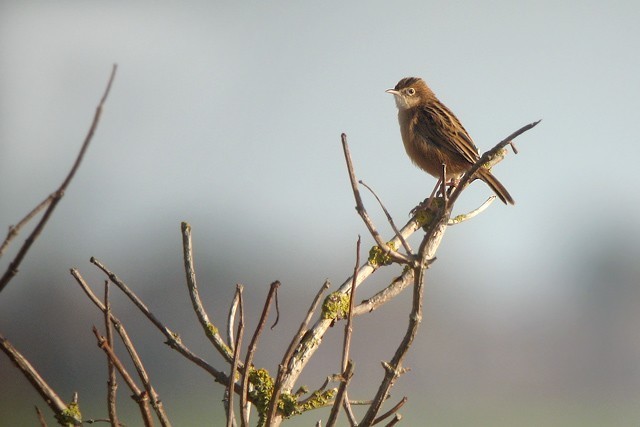
Zitting Cisticola, Pegwell Bay, Kent (Photo: Josh Jones)
A White-billed Diver was seen in Bluemull Sound between Yell and Fetlar (Shetland) on 16th (the same place where one was seen last November, and again in February this year). Around 20 Balearic Shearwaters were seen in British waters this week, including four past Towan Head (Cornwall) on 14th. A further 16 were seen off Jersey, with eight off La Coupe on 15th. Pomarine Skuas were in short supply, well short of double figures. Storm-driven Grey Phalaropes totalled at least 13 birds, with up to four in Dorset (including two off West Bexington) on 14th and one appearing inland the following day at Moatlands GPs (Berkshire).
Little Auks wriggled their way into double figures, with three flying past Severn Beach (Gloucestershire) on the stormy 14th being of note. The tally then jumped considerably when 60 were seen flying past Dunnet Bay (Highland) on 16th. Back in Gloucestershire, the same gales on the same day (14th) saw a juvenile Sabine's Gull fly inland over Slimbridge. Further juvenile Sabine's noted on 14th were seen on St. Mary's (Scilly), at Thurlestone (Devon) and at Chesil Cove (Dorset). Later in the week, an adult Sabine's Gull was seen at Thurlestone on 16th and another (?) juvenile was on Scilly, while the long-staying bird remained in Cork. One last species of note that was caught up by the storm on 14th was Leach's Storm-petrel: at least 10 were noted from Devon to Gloucestershire.

Sabine's Gull, St. Mary's, Isles of Scilly (Photo: Martin Goodey)
In Somerset, the three Glossy Ibis were still at Catcott Lows (Somerset) on 15th–17th, two birds remained at Dungeness (Kent) to 18th and one was still at Tacumshin (Co. Wexford), also to 15th. Another threesome in Somerset were the Cattle Egrets at Walton, on 15th, while two or three were still in Gloucestershire on the same date (two at Frampton, one at Slimbridge). A new bird was seen on the edge of Christchurch Harbour, at Winkton, also on 15th. The loner on Islay (Argyll) was still present on 14th, as was the single bird at Dungeness. Also still in place at "Dunge" was the Great White Egret, and around the country several other birds were still in place too. The returning winterer at Blashford Lakes (Hampshire) was seen on 14th, two birds were still in Suffolk (the bird at Hockwold still playing footsie with Norfolk) and last week's arrival at Slapton Ley (Devon) remained throughout the week. In Lancashire, three birds continued to roost at Leighton Moss off and on during the week, while on 13th one was seen at Crossen's Marsh and two birds flew from Jenny Brown's Point towards Humphrey Head in Cumbria (where a single bird was seen the following day). Others were noted in Aberdeenshire, Moray and Lincolnshire.

Glossy Ibis, Catcott Lows NR, Somerset & Bristol (Photo: Dave Perrett)
Several wintering flocks of Spoonbills continued to entertain this week. Five birds were seen from a cruise along the River Tamar (Cornwall) on 15th and another Cornish quintet were noted at the Walmsley Sanctuary on 12th. Up to five birds were seen in Devon during the week, with just two reported from Dorset (no news on the Poole Harbour wintering flock this week). Elsewhere, two birds remained at Abberton Reservoir (Essex) and four were still at Timoleague (Co. Cork). In the Norfolk Broads, 25 Common Cranes were seen on 14th–15th and, at the other end of the county, three Cranes remained at Welney. A single bird flew over near Dunstable (Bedfordshire) on 15th.
In Lancashire, the four white Snow Geese remained at Leighton Moss over the weekend and continued to generate some interest as to their origins. Other white birds this week remained in Perth & Kinross (to 13th) and northwest Norfolk (to 16th), while a blue morph was at Loch Flemington (Highland) on 15th. A possible blue bird was at Loch of Skene in Aberdeenshire on 14th with, presumably, the same bird (now confirmed) noted leaving the dawn roost at Loch of Strathbeg on 17th.
A Red-breasted Goose of unknown origin was with Greylag Geese near Kirkwall (Orkney) on 12th, and the two birds on Jersey were still present on 11th. Three Black Brants were seen at Ferrybridge (Dorset) on 17th, with singles at Frampton Marsh (Lincolnshire) on 13th–17th, Wells (Norfolk) on 18th and in Ireland at the Wexford Wildfowl Reserve on 15th.
A Richardson's Canada Goose was still at Lissadell (Co. Sligo), present to 17th at least and often with its "medium-sized" Canada Goose sp. buddy nearby (that bird looking like a Lesser or perhaps a Todd's). On Islay, a Richardson's Canada Goose was seen again at Loch Gruinart on 7th.
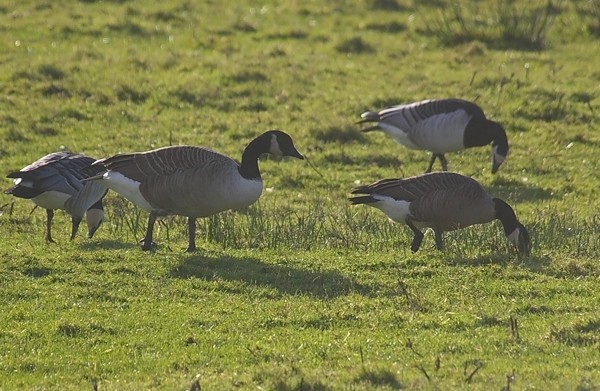
Richardson's Canada Goose, Lissadell, Sligo (Photo: Derek Charles)
Nine Green-winged Teal this week included new birds at Draycote Water (Warwickshire) on 12th–18th, at Eyebrook Reservoir (Leicestershire) on 15th and in Ireland, at Inch Island Lake (Co. Donegal) and Clogheen Marsh (Co. Cork), both on 14th. Others remained at Cley Marshes (Norfolk), Alkborough Flats (Lincolnshire), Kildrochat and Caerlaverock (Dumfries & Galloway) and Belfast Lough (Co. Antrim). Late news concerned the drake Green-winged Teal back again at Bell Harbour (Co. Clare) on 10th.

Green-winged Teal, Draycote Water, Warwickshire (Photo: Dave Hutton)
The week's three American Wigeon, all drakes, were birds from previous review periods: at Castle Loch (Dumfries & Galloway), Loch of Hillwell (Shetland) and The Gearagh (Co. Cork).
In Galway, a drake Lesser Scaup was at Long Point, Loughrea on 14th. In the north of Ireland, a drake Ferruginous Duck was seen at the Craigavon Balancing Lakes (Co. Armagh) on 15th (one was seen here in 2006, 2007 and 2008) and the regular drake was again at Chew Valley Lake (Somerset) on 16th–17th. A female Ferruginous Duck was seen at Old Hall Marshes (Essex) on 15th–16th. As for our Ring-necked Ducks — what's happened to them? None at all were reported this week!
A single drake Surf Scoter was again off Ruddon's Point (Fife) on 15th and a drake King Eider was seen off Burghead (Moray) on 16th–18th.
A Rough-legged Buzzard was reported from Sundridge (Kent) on 12th and, aside from the late lingering Osprey in the Home Counties and a couple of roaming re-introduced White-tailed Eagles in Scotland and Ireland, was the only real raptor of note.
In Gloucestershire, last week's Wilson's Phalarope at Slimbridge was last seen on the afternoon of 12th, then on 14th Lothian's fourth Wilson's Phalarope (and the first since 1987) appeared at Musselburgh Lagoons and remained to 18th. Nearby, at Aberlady Bay, the Lesser Yellowlegs was still in place all week, while new arrivals were seen in both East and North Yorkshire, at Bubwith Ings and Thorganby Ings on 13th and in County Waterford, at The Cunnigar, on 17th–18th.
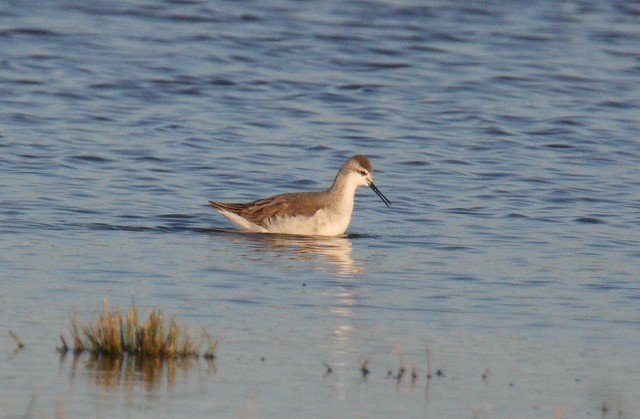
Wilson's Phalarope, Musselburgh Lagoons, Lothian (Photo: Ian Andrews)
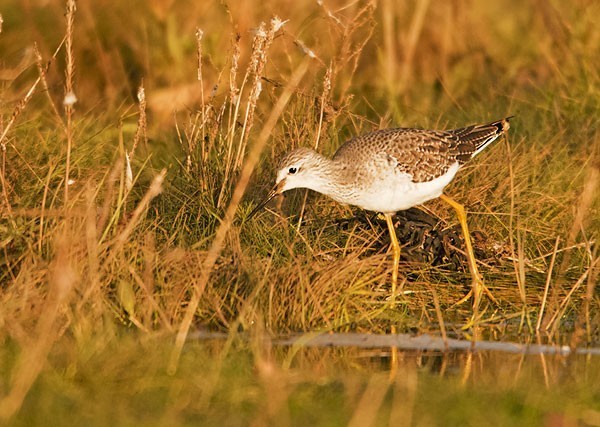
Lesser Yellowlegs, Aberlady Bay, Lothian (Photo: Peter M. Macdonald)
In Essex, a first-winter Spotted Sandpiper was a nice find at Abberton Reservoir on 15th–18th: a first for the site and only the fifth for the county (the most recent record was at Hanningfield Reservoir in December 2001). This bird may have been present since October 15th, when a possible Spotted Sandpiper was reported on the dam, but was then identified as a Common Sandpiper. Another smart find was the Long-billed Dowitcher at Port Carlisle (Cumbria) on 13th, which stayed to 17th at least. There have been just three other records in the county, the most recent being at the very same site as the 2009 bird, a two-day juvenile in September 2005. A second Long-billed Dowitcher appeared at Lough Beg (Co. Antrim) on 15th and was still present on 16th. The north of Ireland was also where the only American Golden Plovers of the week were to be seen, and both in County Down: one was still at Kirkistown on 14th, with another at Newtownards on 15th. A late juvenile Red-necked Phalarope appeared at Far Ings (Lincolnshire) on 17th, reappearing again on 18th.
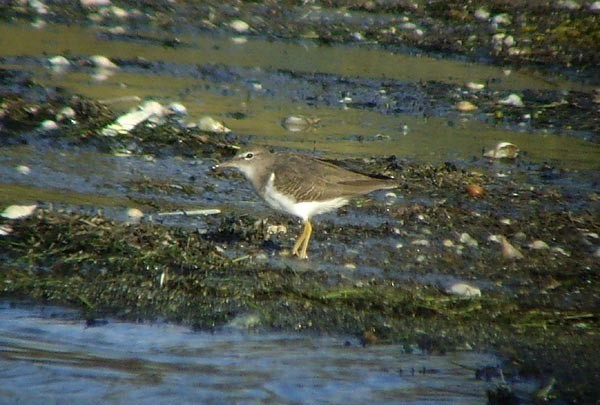
Spotted Sandpiper, Abberton Reservoir, Essex (Photo: Adrian Kettle)

Long-billed Dowitcher, Port Carlisle, Cumbria (Photo: Paul R Massey)

Red-necked Phalarope, Barton-upon-Humber, Lincolnshire (Photo: Graham Catley)
Undoubtedly the smartest gull of the week (actually, the smartest bird of the week) was the beautiful juvenile large Larus sp. seen in Drumcliff Bay, Lissadell (Co. Sligo) on 14th–16th. Showing some features of a young Glaucous-winged Gull, this stunning-looking bird seems most likely to be a hybrid, of High Arctic descent, but quite what the parents are is a tough (and almost impossible) call. American Herring Gull and Glaucous-winged Gull? American Herring Gull and Glaucous Gull? American Herring Gull and Thayer's or Kumlien's Gull? The choices are all there (with suggestions of a particularly well-marked nominate Herring Gull × Glaucous Gull in the mix as well). The unidentified Larid was just one of many gulls feeding along the strandline, taking advantage of a recent mass stranding of Starfish, and sharp eyes also picked out the first Kumlien's Gull of the winter (another juvenile bird), two Iceland Gulls and a first-winter Ring-billed Gull as well.

Gull sp., Lissadell, Sligo (Photo: Declan Skehan)

Gull sp., Lissadell, Sligo (Photo: Míchaél Casey and Declan Skehan)
Elsewhere, other Ring-billed Gulls included the adult again in the roost at Carsington Water (Derbyshire) to 17th and further familiar adults at Gosport (Hampshire) and Oban (Argyll), along with one at Flaggy Shore (Co. Clare). The second-winter Ring-billed Gull was again at Sandymount Strand (Co. Dublin) on 16th, while a new first-winter was on the boating lake at Tramore (Co. Waterford) on 14th.
Single Glaucous Gulls were in Warwickshire and Suffolk this week, while seven more Iceland Gulls were noted: in Greater Manchester, West Yorkshire, Ayrshire, Aberdeenshire, the Outer Hebrides, Orkney and County Cork.
At least 23 Caspian Gulls were noted during the week, with two birds each for Dungeness (on 12th) Minsmere (on 14th), Stewartby Lakes (on 15th), Holt Fen (on 17th) and Stubber's Green (on 18th). Elsewhere, London's gullers found two around the city during the week, with two in Northamptonshire and Warwickshire. Singles elsewhere included a rather handsome third-winter at Cley Marshes (Norfolk) on 15th.

Caspian Gull, Stubber's Green, West Midlands (Photo: Jim Almond)
Red-rumped Swallow number 11 for the autumn was found on Holy Island (Northumberland) on 13th, and showed rather well from time to time, while bird 12 of the past few weeks appeared at Eyemouth (Borders) on 18th. On Orkney a possible Little Swift was seen briefly flying over Marwick Head on 16th, and a presumed Black-bellied Dipper was seen on North Ronaldsay.

Red-rumped Swallow, Holy Island, Northumberland (Photo: Andy Mould)
The dazzling male Bluethroat at Ballycotton (Co. Cork) continued to show off between 12th and 16th, while the dowdy-by-comparison female, at Errol (Perth & Kinross), remained to 15th at least. Back at Ballycotton, the obliging Red-throated Pipit resurfaced on 14th. The (rather small) haul of Richard's Pipits was almost entirely centred around Gloucestershire — two birds were at Slimbridge on 13th–14th, with singles at New Passage on 14th and Berkeley Power Station on 15th. The only other Richard's Pipit this week was seen on St. Mary's (Scilly) on 14th–15th.
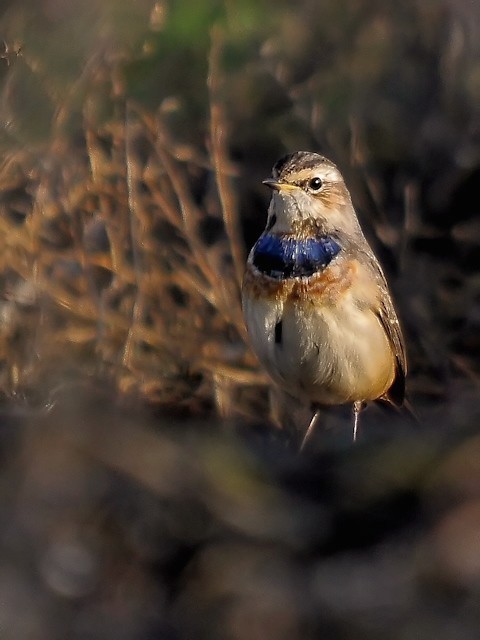
Bluethroat, Ballycotton, Cork (Photo: Ronan mclaughlin)
Eight Great Grey Shrikes were reported during the week, and all of them had been recorded before this past seven days. In the southwest, singles remained at Fernworthy Reservoir (Devon) and Westbury-sub-Mendip (Somerset), while over in Hampshire another was still in the New Forest, at the Holmsley Inclosure. The Great Grey Shrike at Dersingham Bog (Norfolk) was a popular weekend attraction and one was reported near Louth (Lincolnshire). In the north of England, singles were seen at Wykeham Forest (North Yorkshire) and again at Thorne Moors (South Yorkshire) — one was seen here in mid-October — and one remained at Dalton Crags (Cumbria). In Wales, a Great Grey Shrike was seen at Llanwrthwl (Powys) on 17th.

Great Grey Shrike, Holmsley Inclosure, Hampshire (Photo: Granville Burn)
Just five Yellow-browed Warblers were seen this week: one each for Scilly, Cornwall, Kent, Lincolnshire and, notably, Berkshire, with one seen at Lower Farm GP on 13th following one at Wraysbury the week before.
The juvenile Rose-coloured Starling was still at Forest Hill (Oxfordshire) between 12th and 15th. In Kent, Dungeness scored with three Penduline Tits on 15th–18th. The RSPB reserve at Rainham Marshes (London) popped in a couple of Serins on 15th, with both birds seen, off and on, to 17th and one there on 18th as well (this time last year, a remarkable seven birds were seen at the same site). Finally, a flock of 18 Northern Bullfinches was seen at Strath Carnaig (Highland) on 18th.

Penduline Tit, Dungeness RSPB, Kent (Photo: Adam Whitehouse)
Photo of the Week

Eider, Bamburgh, Northumberland (Photo:
Nigel Tinlin)
Many bird photographers take photos only in their preferred lighting conditions, such as diffuse sunlight or cloudy-bright lighting. As soon as the sun starts to go down or the onset of rain threatens, they pack up their gear for the day. What those photographers miss, though, is a whole range of opportunities for great atmospheric shots. Northumberland-based photographer Nigel Tinlin uploaded an excellent example this week, featuring an evocative view out to sea with the Farne Islands in the distance and with the whole scene bathed in the rich hues of a brilliant rainbow. With the rainbow filling the sky in the upper third of the image and its reflection in the wet sand providing a balanced foreground in the lower third, all that was needed for a stunning composition was a focal point. In one of those once-in-a-lifetime moments, Nigel was then blessed with a small group of Eider waddling along the shoreline, arranged and posed with perfect precision. That'll do nicely!
Other notable photos

Sanderling, Titchwell RSPB, Norfolk (Photo:
Douglas McFarlane)

Barn Owl, undisclosed site, Suffolk (Photo:
Amanda Hayes)

Mute Swan, Kensington Gardens, Greater London (Photo:
Fraser Simpson)

Marsh Harrier, Minsmere RSPB, Suffolk (Photo:
Jon Evans)
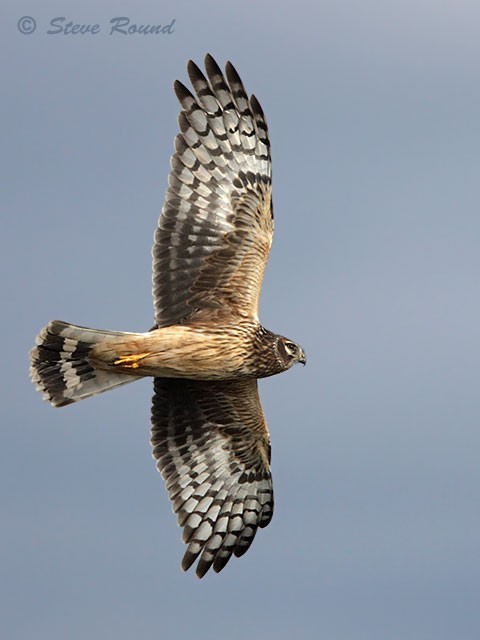
Hen Harrier, Inner Marsh Farm RSPB, Cheshire (Photo:
Steve Round)

Sparrowhawk, Cley Marshes NWT, Norfolk (Photo:
Glyn Herrieven)
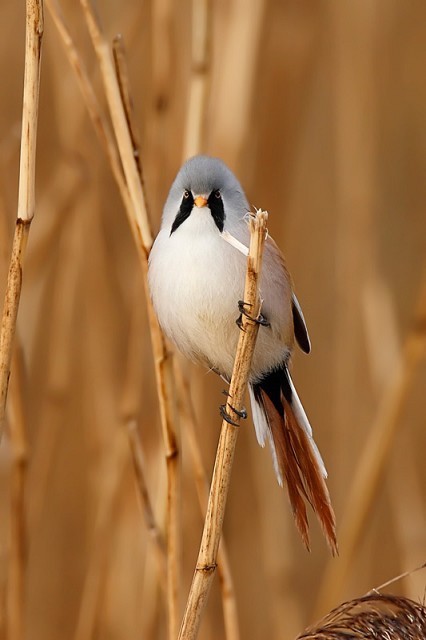
Bearded Tit, Holy Island, Northumberland (Photo:
Tom Tams)

Goldcrest, undisclosed site, Greater Manchester (Photo:
David Cookson)

Shoveler, Cley Marshes NWT, Norfolk (Photo:
Richard Bedford)

Common Kingfisher, Tibberton, Worcestershire (Photo:
Mark Hancox)

Jay, North Wirral, Cheshire (Photo:
Richard Steel)
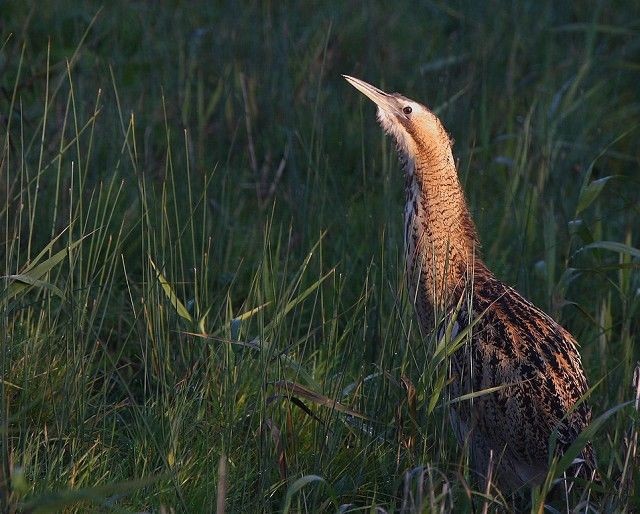
Bittern, Far Ings NR, Lincolnshire (Photo:
Don Davis)

Tawny Owl, Ross-on-Wye, Herefordshire (Photo:
Brian Davis)

Nuthatch, private site, Norfolk (Photo:
David Whistlecraft)
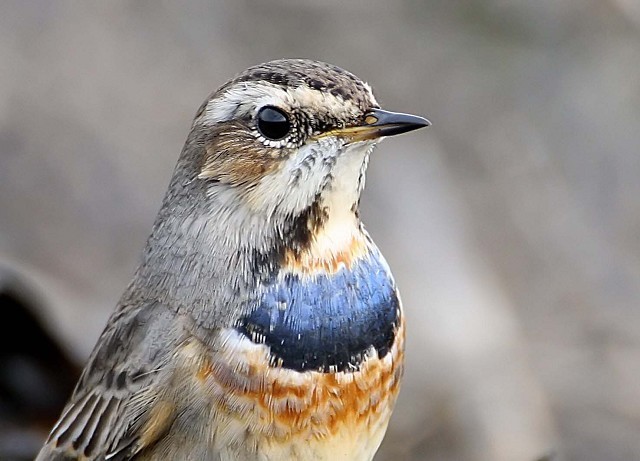
Bluethroat, Ballycotton, Cork (Photo:
Sean Cronin)

Many-coloured Rush-tyrant, Argentina (Photo:
David Brassington)
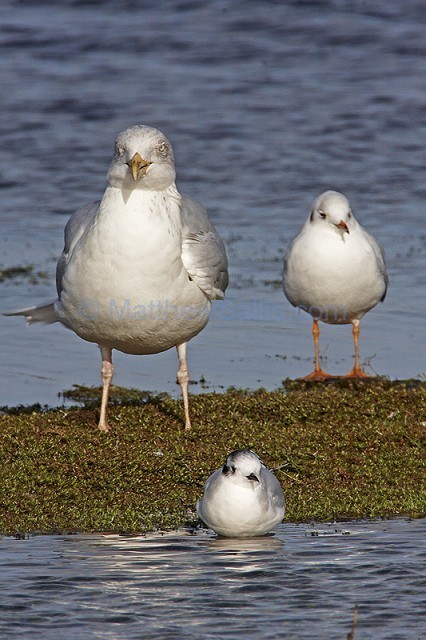
Little Gull, Stithians Reservoir, Cornwall (Photo:
Matthew Sallis)

